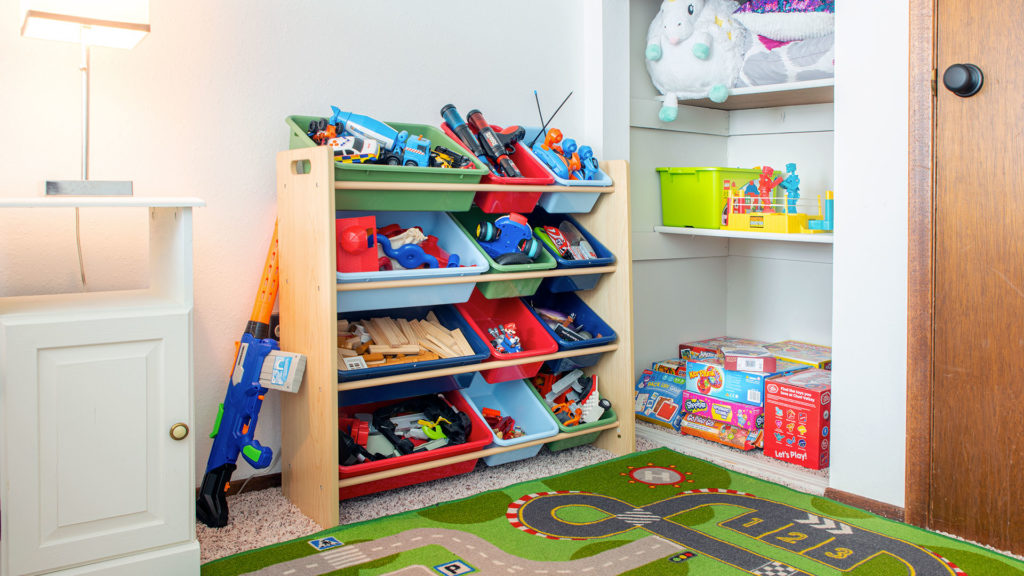In households with young children, nothing accumulates faster than toys. Few parents are immune to the struggles of figuring out a place to store everything so the house isn’t cluttered. If you’ve ever had the misfortune of stepping on a Lego while barefoot (an injury that ranks second only to a papercut in terms of sheer agony), you’re going to be even more motivated to get all that stuff put away. Fortunately, there are plenty of creative solutions for tidying up your home…and reducing the odds of bodily injury!
Turning a spare room into a playroom is a great way to keep your house neat while providing your kids with a dedicated place to play. Even if you don’t have the space to set aside an entire room for your kids’ Barbies and Hot Wheels, there are still things you can do to keep your home organized and your children entertained.
John and Sarah Enos know the struggle well. They are parents to two children of their own (Reign and Micah), as well as three additional foster kids. They also happen to own VL Homes, a residential remodel and design company in Rapid City, along with John’s brother Dan and his wife, Erin. This makes them ideally suited to offer practical advice on creating a playroom or separate space for kids.


The pair, who met before attending college at Black Hills State University, didn’t originally set out to be business owners. Both began their professional careers as teachers, but after their daughter was born, they felt the pull to go in a different direction. John enjoyed building things and working with his hands and Sarah had a passion for designing, so they decided to fulfill their dream of starting their own business and formed VL Homes in 2018. The company’s goal is to remodel homes and renovate lives, and they have been successful in both endeavors.
As their own family grew, they needed to figure out how best to use the limited space available to them. Their solution was simple, and one many parents turn to: creating a play area for their kids. This involved a bit of pre-planning first.


“You really have to decide what’s important,” John says. “Ask yourself, is your room about creating an impression for guests, or truly designed for kids to play in? Kids won’t use a space if they don’t feel they can actually play there.”
“When you’re considering a playspace, organization is key,” Sarah adds. “Design has to meet function. You want a beautifully aesthetic space that [allows you] to do what you want.”
The secret to organization is making the playspace kid-accessible. You’ll want to store toys at the child’s level, so they can take them out and put them away. John and Sarah are proponents of storage cubes and bins that are reserved for separate toys. Places like IKEA offer a wide selection of functional, inexpensive options. One cube might contain dolls, another could house blocks, etc. This not only makes it easy to find favorite toys, but teaches children to pick up after themselves and put toys away where they belong. Toy boxes seem like a good idea in theory, but often prove challenging because everything gets thrown in together and then kids don’t play with them as much. Another key strategy involves rotating toys, putting some aside and bringing them out only occasionally so children won’t grow bored with them. These can be stored in a garage or closet when not in use. Don’t be afraid to pass them down to cousins or donate to thrift stores when your kids are no longer interested in them.


While a dedicated playroom is ideal, not everybody has that luxury. You might have to designate a room to serve double-duty, perhaps creating a playspace in a guest room or home office. If you go this route, John suggests adding a shelving system where kids’ toys occupy the lower shelves and other items are stored higher, out of reach of little hands. If guests will be sleeping there occasionally, a convertible day bed is an excellent option. While less common nowadays, a Murphy bed that slides vertically against a wall is a great space-saver. Arrange furniture with safety in mind (e.g., place a recliner in a corner where you aren’t likely to get hit by flying toys), and invest in washable slipcovers or, if your budget allows, leather furniture, which is durable and easy to clean. Don’t fill the room with expensive or hard-to-replace items like heirloom vases or fancy lamps; even the best-behaved kids break things. John and Sarah like to seek out thrift stores for inexpensive items that are still aesthetically pleasing but functional and don’t have sentimental value. In a larger space, such as a basement, keep in mind that kids love forts and cubby holes.
You can even get creative in small spaces. If you’re living in a tiny apartment while saving up for a down payment on a house, a bookcase with dedicated shelves and a few storage cubes will go a long way toward clutter-free living quarters and kids will feel like you are inviting them into your shared space.
With a final piece of advice, John urges: “Let kids be creative, play, and have fun!”
Written by Mark Petruska
Playroom Photos by Jesse Brown Nelson
Family Photo by Alyssa Crawford Photography; VL Homes Photo by Riley Winter Photography
featured in the spring 2020 issue of BHParent magazine

